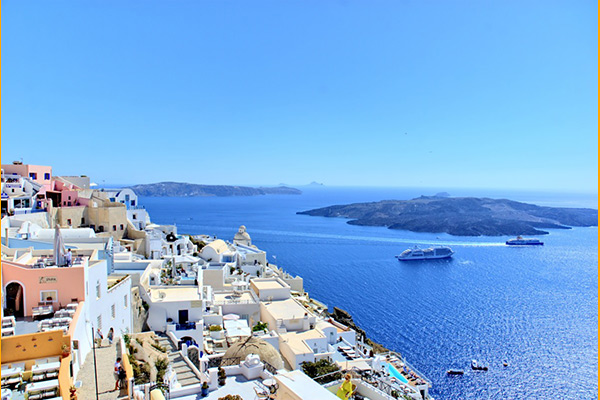
GET THE LATEST CRUISE DEALS

GET THE LATEST CRUISE DEALS



Birthplace of democracy, the Olympics and philosophy, Greece is a country with an unmatched historical and cultural heritage. Its ancient wonders, including the iconic Parthenon, capture the imagination of all its tourists. Aside from these treasures of the past, Greece also has 1,400 islands sprinkled along the rich, blue waters of the Aegean, Ionian and Mediterranean Seas. Here, modern-day adventurers can experience all the wonders that have been written about in Greek legends for thousands of years.
Just 30 minutes from the port of Piraeus lies the ancient city of Athens. With its magnificent architecture, legendary cultural attractions and unparalleled place in history, this capital city known as "the cradle of Western civilization" is a must-see destination for world travellers. A captivating blend of the classical and the contemporary, Athens boasts some of the world's oldest and most renowned landmarks, and wears its ancient heritage proudly.
Attractions
Chaniá is the second largest city of Crete, and one of the most beautiful. It lies along the north coast of the island at the east end of the Gulf of Chaniá. Chaniá is the site of the ancient Minoan settlement the Greeks called Cydonia (Kydonia), which was mentioned in Virgil's Aeneid. The site has been continuously inhabited from Neolithic times-at least 5000 years. The city's rich history can be traced through historic buildings and monuments with Venetian, Turkish and Greek architecture.
Known as the "Emerald Island" because of its lush greenery and breathtaking beauty, Corfu is one of the hidden treasures of the Mediterranean. Possessing an intense culture and unparalleled coastline, the island has provided endless inspiration for many artists and literary figures. One of the most beautiful islands in all of the Mediterranean, Corfu casts a magical spell on those fortunate enough to visit its shores. Silvery olive trees grace the countryside, lemon trees scent the air, vivid blooms catch your eye, and the sapphire sea against the verdant land is a stunning contrast. Corfu is undoubtedly the greenest island in all of Greece. A leisure stroll through the narrow alleyways will reveal many local treasures from fine wines to fresh seafood.
Attractions
Iraklion, the capital city of Crete, rests on the side of a hill overlooking the Cretan Sea. The city is named after Hercules (Herakles, or in Modern Greek, Iraklis). Though a bustling metropolis, Iraklion is also the gateway to the nearby stunning ancient ruins of advanced civilizations. Discover Crete’s astonishing Minoan sites. Or simply bask on the glorious north coast beaches or socialize and people-watch in the cafés and restaurants of Platía Venizélou (Fountain Square).
Attractions
Whether you're into sports, history, art, or just lounging by the sea, the charming village of Katakolon is a good place to start. From here, it's just a quick trip to famed Olympia, birthplace of the modern Olympics and one-time home to a Wonder of the Ancient World. Or, if you're looking to do like the locals do - grab a seat at one of the town's seaside cafés and order a cool drink and some local mezes (Greek snacks).
Attractions
In the deep blue waters of the Mediterranean lies one of the most inviting places in all of Greece - Mykonos. Its countless bays and beaches and its quaint cobblestone streets are bound to welcome any visitor. According to Greek mythology, it was here that Hercules slew the Giants; the large rocks that are scattered about the island are said to be their petrified corpses. True or not, you'll have to judge for yourself. Either way, the Island of Mykonos should not be missed.
Attractions
Residing on the eastern coast of the Peloponnese peninsula, Nauplion is characterised by the Palmadi Fortress - a shining example of the city's Venetian occupation in the 15th century. The picturesque vista showcasing the Greek Islands is certainly worth the 999-step climb.
Rhodes, the largest of the Dodecanese Islands and the friendliest city in the Mediterranean, is truly a vacation destination with something for everyone: eternal sunshine, spectacular beaches on the Aegean Sea, a medieval walled city, an ancient acropolis, and much more. In ancient times, the people of Rhodes chose Helios, the Sun, as their divine patron. With an average of three hundred plus days of sunshine a year, the most number of sunny days in all of Europe, it's safe to say that Helios continues to smile upon Rhodes today.
This sunny retreat is also home to many historic sites ranging from the ruins of the Temple of Venus to the medieval Street of Knights.
Attractions
Black sand beaches, crystal-clear waters and villages of whitewashed houses accented with blue roofs on the side of volcanic cliffs make the island of Santorini a wonder to behold. Many visitors come to Santorini to uncover the mysteries of the lost kingdom of Atlantis, while others revel in its relaxed mountaintop atmosphere to enjoy the scenic waters of the Mediterranean.
Attractions
Strategically nestled on the Pagasitic Gulf, at the foot of Mount Pelion, the town of Volos offers many unique opportunities. Highly recommended: an excursion to the Meteora Monasteries, a geological phenomenon perched high above massive granite rocks, hundreds of feet in the air (made famous in James Bond film, For Your Eyes Only). Volos is also renowned for its tsipouradika, charming waterfront dining establishments where you can sample tidbits of fresh seafood along with the local drink, tsipouro.